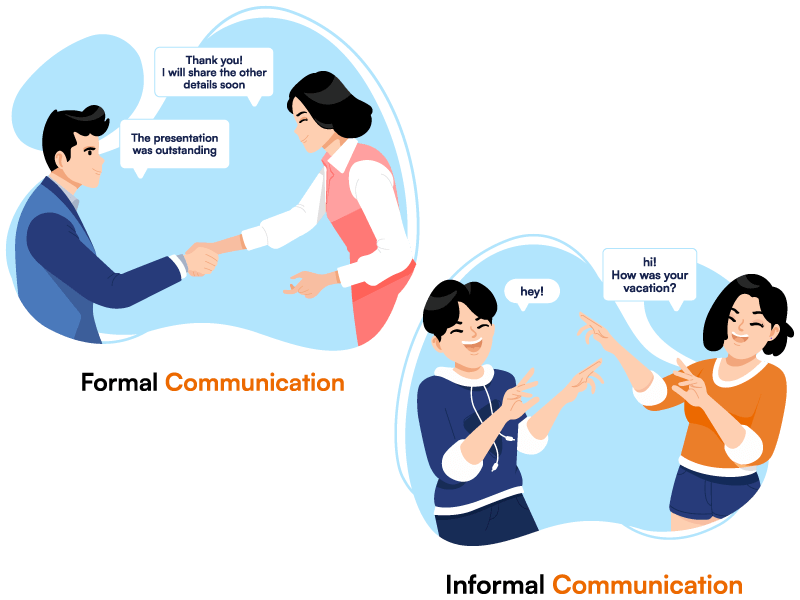Informal Communication
Table of Contents
What is Informal Communication?
Informal communication is the natural, friendly, and casual communication among the co-workers in the company. It doesn’t follow any defined communication structure or hierarchical order but is expressed based on the social relationship built among the people in the organization.
Example of informal communication at the workplace
- Imagine a company that has 50 employees.
- The tea break started, and some employees went to the canteen.
- Ten of the employees sat together and discussed a new movie release.
- The communication that the 10 employees have with each other is termed informal communication.
Informal communication is essential for organizations because it improves the employees’ morale, builds strong relations, and encourages their feeling of belonging among their coworkers and the company. With the help of the below image, you can clearly understand the difference between formal and informal communication.


Drawbacks of Informal Communication Within Your Organisation
Drawbacks of informal communication in an organization include the risk of spreading misinformation and rumors, lack of accountability and documentation, potential exclusion of individuals, and the possibility of misinterpretation.
Organizations must balance informal and formal communication channels to mitigate these drawbacks and ensure effective and transparent communication. The drawbacks of informal communication in an organization can have several negative impacts.
Here are the main drawbacks
Misinformation and Rumors
Informal communication can spread rumors and misinformation, which can easily and quickly circulate throughout the organization. This can create a climate of uncertainty and unease among employees and negatively impact the organization's culture and productivity.
Lack of Accountability
Informal communication often lacks the structure and accountability formal channels provide. As a result, important decisions and actions may not be properly documented or traced back to their origin and leadin' to confusion and potential conflicts.
Exclusions
Informal communication networks can lead to the exclusion of specific individuals or groups within the organization. This can create feelings of isolation and marginalization and ultimately impactin' morale an' collaboration.
Lack of Documentation
Unlike formal channels and informal communication often lack proper documentation. This can lead to misunderstandings and disputes and difficulty in tracin' the origin of information or decisions.
Potential Misinterpretation
Informal communication may lead to misinterpretation of messages or the tone of the conversation which can result in conflicts an' misunderstandings among individuals or teams.

How do you Avoid Informal Communication Within The Organisation?
To avoid informal communication within the organization, it is important to take the following steps:
Familiarize Yourself with Workplace Culture
It is important to familiarize oneself with the workplace culture and the expected level of formality to ensure effective communication.
Think Before You Speak
It's important to take a moment and think before we speak or write. Our words have immense power and can have a significant impact on others. We should consider the tone, content, and audience before communicating.
Set Boundaries for Informal Communications
It is important to distinguish between informal and formal communication and encourage adherence to formal channels for conveying important information.
Explain How the Organization Communicates
Informal communication is any communication that occurs outside formal channels. It can include personal conversations and gossip. It can also spread misinformation, lack accountability, and exclusions, have no documentation, and lead to misinterpretation.
Organizations must balance informal and formal communication channels to minimize negative impacts and ensure essential information is communicated effectively.
Create an Information Dissemination Plan
Establish a structured approach for sharing information, ensuring it is communicated formally through approved channels. Regularly review and assess the effectiveness of formal communication methods to ensure they are followed and produce the desired results.
Organizations can create a more professional communication environment by reducing informal communication.

Frequently Asked Questions
What are the common types of informal communication?
Informal communication can be conveyed in any form. However, there are mainly four types of informal communication.
- Single strand
- Gossip chain
- Probability chain
- Cluster chain
What are the advantages of informal communication?
Informal communication allows giving a personal view of the employees' needs and discussions. Employees can have a better chance to raise their concerns about work-related issues. Due to this, the employees can be in a co-ordinal environment.
What are the demerits of informal communication?
The lack of secrecy due to no formal record of communication leads to a more significant loss to the organization. It wastes a lot of time as sometimes informal communication may provide only half of the information, which causes conflicts. On the other hand, it leads to a need for more innovative ideas and creativity decreases.
What are the features of informal communication?
Informal communication is not formal but is often practiced. Many times it can take the form of gossip and lead to consequences. There is no proper structure to informal communication, which causes a lack of complete information.
How does informal communication occur?
Informal communication is a kind of communication that doesn’t occur in any kind of formal structure or official manner. It can be conveyed in any manner, such as it can be spoken, written, or conveyed by body language. It can be personal conversation or gossip, which is not practiced in any official manner.

People also search for
Modify your HR and payroll tasks with factoHR today
Let your HR and workforce focus on most important business decisions while factoHR can reduce the burden of daily activities of the organization.

© 2026 Copyright factoHR


